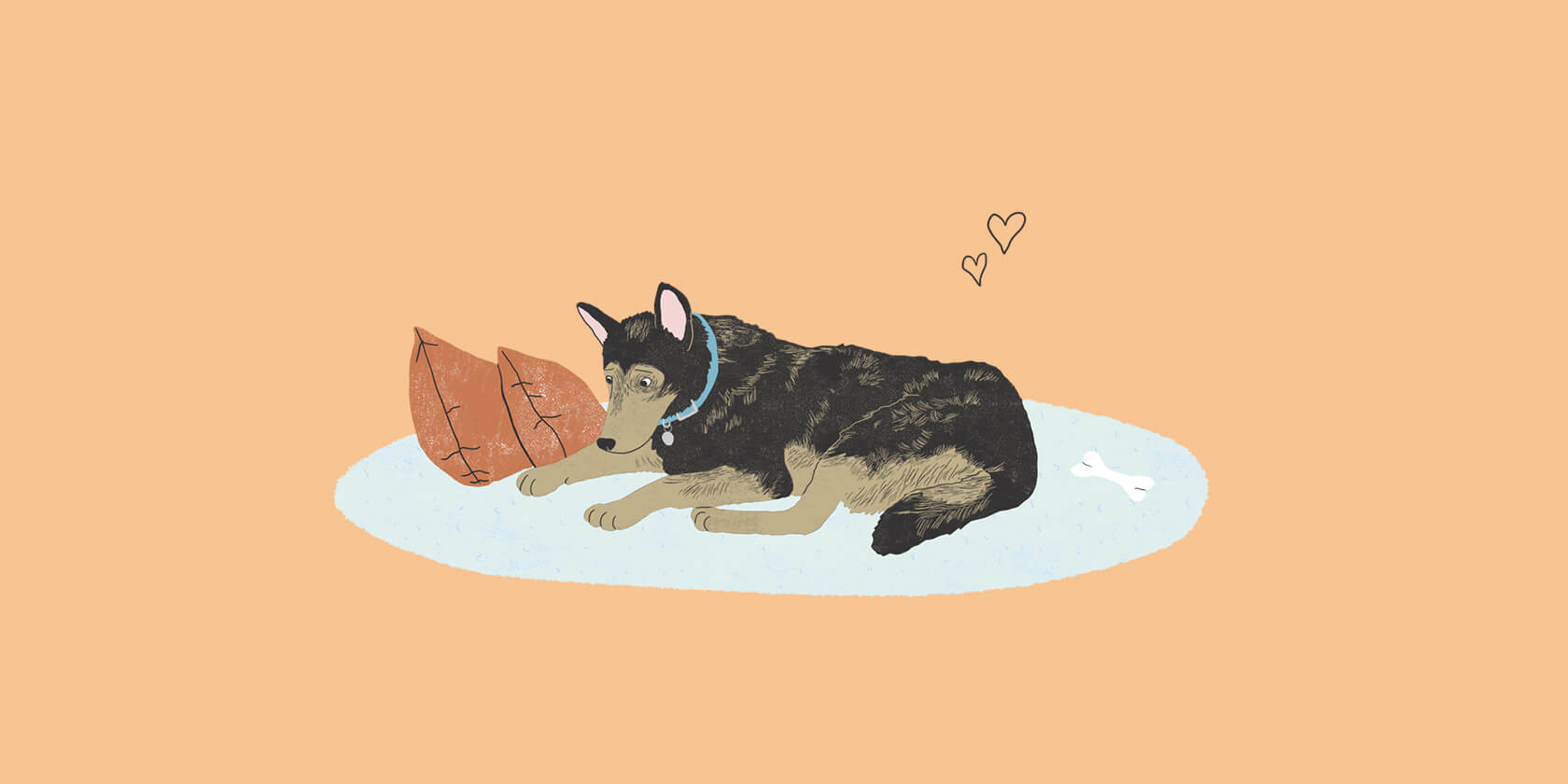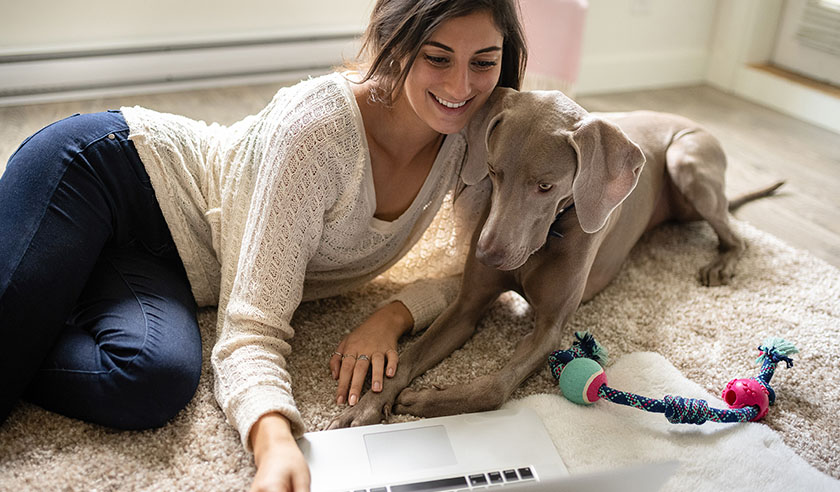If you've noticed that your dog seems to have less zest for life than usual, you might be wondering if they're depressed. Like humans, our pets can experience negative emotions. While we cannot assume our dogs experience depression the same as that diagnosed in humans, our dogs can experience many of the same emotions we do[1], such as sadness, fear, anxiety, and sometimes even grief. You want your dog to be happy and healthy, so paying attention to their emotional well being is important.
Let's look at what can cause negative emotions in dogs, signs your dog might be showing, and how you can help your dog feel better.
What Causes Anxiety and Fear in Dogs?
Anxiety and fear are common emotions felt among dogs as well as by people, cats, and horses. In the short term, anxiety and fear are important emotions that tell the dog when something dangerous is about to happen. Anxiety and fear act like an early warning system and allows the dog to take actions to either run away from the situation, fight their foe, or freeze and hope that the danger does not recognize them. But anxiety and fear can become maladaptive or unhealthy when the emotions are too intense for the situation, experienced frequently, or last for a long period of time. Long term or repeated exposure to situations that cause anxiety and fear can cause changes in the brain due to chronic and intense exposure to stress hormones, such as cortisol or adrenaline. This might happen because of a traumatic life change or event, such as:
- Moving
- Being rehomed
- Loss of a family member (human or another pet)
- Addition of a new family member (like a new baby)
- Routine change (such as an owner working outside of the home more often than before)
Genetics can also play a factor in how a dog responds to changes in their environment or new experiences. Where one dog may develop severe anxiety and fear after moving to a new home, another dog may be ok with the move. Learning how to read your dog's emotions is critical to their emotional well being.

Additionally, a dog can also become anxious or fearful from a build-up of stress over time, known as "trigger stacking." For example, during the COVID pandemic, many dogs became used to having their parents work from home. Additionally, they were not going to dog parks or otherwise socializing with other dogs. During this time, we were also receiving more packages by delivery, which could be upsetting to our dogs. Once the pandemic was over, we started going back to work and interactions with other dogs increased, such as going back to the dog park or dropping them off a doggie day care. In addition, packages kept getting delivered and we were not home to reassure of dogs that it was okay. While each of these changes could be managed individually, stacking many one on top of the other repeatedly can lead problematic anxiety and unhealthy fear responses.
Fear and anxiety can also lead to a dog appearing "depressed" due to increased stress hormones in their system. If a dog has a scary experience, it can take time for cortisol levels or adrenaline to return to normal. If something scary happens again before their brain has a chance to recover, these levels spike again. It can become a cycle of stress, which is a lot for a dog to deal with and can end up with our canine friend experiencing unhealthy levels of fear or generalized anxiety.
There are illnesses and medical conditions that share the same symptoms of generalized anxiety and unhealthy fears, which is why it's crucial to make an appointment with your veterinarian first. Dogs are very good at hiding pain or discomfort, which makes paying attention to their emotional well being even more important. In fact, anxiety and fear can make pain worse and alternatively, pain can be a trigger for fear and anxiety. Your veterinarian will work with you to determine the cause of your dog's changes in behavior and prescribe a treatment plan that is right for your dog.
Signs of Fear and Anxiety in Dogs
The signs of fear and anxiety in dogs are similar to symptoms that humans feel when they’re anxious or fearful. Unfortunately, we can’t ask our dogs how they're feeling. We have to pay close attention to their physical signs and body language that can give us a glimpse into their emotional state. You might notice your dog seems to be "moping" around or just doesn't seem as enthusiastic as usual.
Here are more obvious signs of anxiety or fear to watch for:
- Change in sleeping habits. Is your dog sleeping more or less than usual? Are they wanting to sleep in a different area than before, perhaps a more secluded area?
- Lack of energy. Is your dog acting more lethargic or less active? Do they seem less enthused about activities they once enjoyed?
- Change in eating habits. Has your dog not been interested in their regular meals? Have they become picky in what food or treats they eat? If the dog eats treats, when do they eat them? This can give you a clue as to what situations are causing them anxiety and fear. For example, does your dog always take their treats except during thunderstorms? That is an indication that they have thunderstorm anxiety or phobia.
- Withdrawal. A dog who is anxious or fearful might seek solitude and not want to interact with their family as much as before. Has your dog begun to hide in other rooms rather than cuddle up on the couch? Do they retreat from social interactions when they used to love greeting guests? Again, when this happens can give you a clue to what is causing their anxiety and fear. Do they withdraw and hide when your children's friends come over to play? The noise and activity may be overwhelming for your dog.
- Obsessive licking or chewing. Has your dog begun continually licking themselves, the floor, other objects, or even the air? Many dogs feeling anxious or distressed will try to self-soothe by licking or chewing on themselves or other things, most often their paws. Frequent paw licking is most often a medical problem, such as allergies or possibly due to pain.
These symptoms can also be signs of illness or injury, which is why a veterinary exam is necessary to rule out other causes as part of addressing your dog's behavior changes. You know your dog best — if their behavior seems off to you, that's enough to bring it up to your veterinarian.
How to Help a Dog with Anxiety and Fear
If your dog is experiencing anxiety or fear, you can do a few things to help them get through it.
- Exercise. Physical activity boosts your dog's production of the feel-good hormones in their brain, such as serotonin and dopamine. These counteract the stress hormones and help your dog feel better, boost their appetite, and regulate sleep patterns. A word of caution: If your dog is afraid of things that they may encounter on a walk (such as the dog that runs back and forth along the fence barking and growling) consider taking another route or engaging in one of the other exercises listed below.
- Cooperative play. Engage your dog in fun games and activities. This might be playing hide and seek around the home or fetch in the backyard. That social contact and just having fun can be a big mood-booster for both of you.
- Sniffing. Sniffing is naturally calming and a big stress-reliever for dogs. Some dogs may actually "see" the world better with their nose than with their eyes! Sniffing also lowers a dog's heart rate, even while they're walking[2]. Take a trip outdoors with your dog and allow them to sniff to their heart's content.
- Reward happy moments. Any time your dog shows a happy or excited response to something, make sure to notice and praise them. Take note of what sparked joy for them and try to work more of that into their day-to-day. You can also use this positive reinforcement to help your dog anticipate that something good is coming. Ask for a simple sit before petting, giving a treat, or putting on a leash. An advantage for you is once they learn these commands, you will have better control of them during times where they are excited.
- Dog companionship. If your dog is more anxious, fearful, or appears to be grieving because they recently lost another pet's companionship, adding a new furry friend to your home might help. However, it's important to carefully consider whether it's best for everyone in your home and then find the best match for your dog's new friend. If adding another dog or pet isn't feasible for you, consider setting up playdates with dogs that your dog enjoys being with.
- Supplements and medication. In some cases, adding calming supplements can help your dog feel better. Be sure to talk to your veterinarian before adding any supplement or nutraceutical to your pet’s diet, as they are not all created equal or always as safe as they seem. In some cases of generalized anxiety and fear, your veterinarian or veterinary behaviorist might prescribe anti-anxiety medication or anti-depressants. These could be similar to anti-anxiety medications prescribed for people, but often the dose and formulation is different for your dog, so never administer any medication to your dog that has not been prescribed by your veterinarian. It may seem odd at first, but when you think about how fear and anxiety develop and the parts of the brain at work, it makes sense that the treatments might be similar for people and pets.
If you think your dog might be anxious or fearful, your first step is to speak with your veterinarian about your concerns. They can determine if something is going on that's causing your dog's behavior and then help guide you through a treatment plan. Above all, be patient. Remember, the change in your dog's behavior or emotional well-being did not happen overnight, but was the result of multiple stressors over a period of time. So, it will take some time to reverse these changes. This can certainly be frustrating or make you feel like you're not doing enough. Try not to rush the process and celebrate progress as it happens, as each small step gets you closer to your goal of improving your dog's behaviors and well-being. With a little compassion and understanding, you'll both feel better over time.
ZPC-01221R1
- Panksepp, K. The Basic Emotional Circuits on Mammalian Brains: Do Animals have Affective Lives?: Neuroscience and Biobehavioural Reviews. Volume 35. Pages 1791-1804. 2011.
- SAt the Heart of the Walk. Dog Field Study. http://www.dogfieldstudy.com/node/1. Accessed March 3, 2021.





.jpg)

